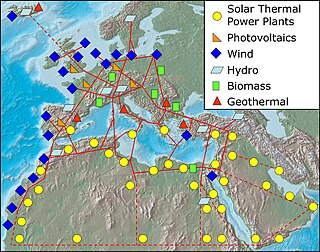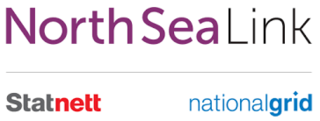
The energy policy of the European Union focuses on energy security, sustainability, and integrating the energy markets of member states. An increasingly important part of it is climate policy. A key energy policy adopted in 2009 is the 20/20/20 objectives, binding for all EU Member States. The target involved increasing the share of renewable energy in its final energy use to 20%, reduce greenhouse gases by 20% and increase energy efficiency by 20%. After this target was met, new targets for 2030 were set at a 55% reduction of greenhouse gas emissions by 2030 as part of the European Green Deal. After the Russian invasion of Ukraine, the EU's energy policy turned more towards energy security in their REPowerEU policy package, which boosts both renewable deployment and fossil fuel infrastructure for alternative suppliers.
Eddie O'Connor is an Irish businessman who is co-founder and chairman of Mainstream Renewable Power, a renewable energy group.
DESERTEC is a non-profit foundation that focuses on the production of renewable energy in desert regions The project aims to create a global renewable energy plan based on the concept of harnessing sustainable powers, from sites where renewable sources of energy are more abundant, and transferring it through high-voltage direct current transmission to consumption centers. The foundation also works on concepts involving green hydrogen. Multiple types of renewable energy sources are envisioned, but their plan is centered around the natural climate of the deserts.
TenneT is a transmission system operator in the Netherlands and in a large part of Germany.

The Burbo Bank Offshore Wind Farm is a 348 MW offshore wind farm located on the Burbo Flats in Liverpool Bay on the west coast of the UK in the Irish Sea. It consists of an original 90 MW wind farm commissioned in 2007 and a 258 MW extension completed in 2017.

The SuperSmart Grid (SSG) is a hypothetical wide area electricity network connecting Europe with northern Africa, the Middle East, and the IPS/UPS system of CIS countries. The system would unify super grid and smart grid capabilities into a comprehensive network. There are no planned locations for infrastructure or schedule explicitly for the SSG; the name is used to discuss the economic and technological feasibility of such a network and ways that it might gain political support.

A super grid or supergrid is a wide-area transmission network, generally trans-continental or multinational, that is intended to make possible the trade of high volumes of electricity across great distances. It is sometimes also referred to as a "mega grid". Super grids typically are proposed to use high-voltage direct current (HVDC) to transmit electricity long distances. The latest generation of HVDC power lines can transmit energy with losses of only 1.6% per 1,000 km.
The electricity sectors of the Republic of Ireland and Northern Ireland are integrated and supply 2.5 million customers from a combination of coal, peat, natural gas, wind and hydropower. In 2022, 34 TWh were generated. In 2018 natural gas produced 51.8%, while wind turbines generated 28.1%, coal 7%, and peat 6.8% of Ireland's average electricity demand. In 2020 wind turbines generated 36.3% of Ireland's electrical demand, one of the highest wind power proportions in the world. While the United Kingdom was one of the first countries in the world to deploy commercial nuclear power plants, the island of Ireland has never had a nuclear power plant built on either side of the Irish border. Nuclear power in Ireland was discussed in the 1960s and 1970s but ultimately never phased in, with legislation now in place explicitly forbidding its introduction.

The European super grid is a possible future super grid that would ultimately interconnect the various European countries and the regions around Europe's borders – including North Africa, Kazakhstan, and Turkey – with a high-voltage direct current (HVDC) power grid.

Offshore wind power or offshore wind energy is the generation of electricity through wind farms in bodies of water, usually at sea. There are higher wind speeds offshore than on land, so offshore farms generate more electricity per amount of capacity installed. Offshore wind farms are also less controversial than those on land, as they have less impact on people and the landscape.
ISLES was a project that ran from 2010–2015. Its purpose was to facilitate the development of offshore renewable resources, such as wind, wave and tidal energy, and renewable energy trade between Scotland, Republic of Ireland and Northern Ireland. It assessed the feasibility, and developed a conception, of creating an integrated offshore transmission network connecting renewable energy project sites located off the west coast of Scotland, north and east coasts of Northern Ireland, west coast of Ireland and in the Irish Sea with onshore grids. It was a joint project between the governments of Scotland, Ireland and Northern Ireland, funded primarily by the European Union's INTERREG IVA Programme. Funding from INTERREG was approximately €2 million.

The North Sea Link is a 1,400 MW high-voltage direct current submarine power cable between Norway and the United Kingdom.
The Polish energy sector is the fifth largest in Europe. In 2022, the country consumed 13.16 TWh of electricity, importing 3 114 GWh thereof.
Medgrid project, created at the end of 2010 in Paris, is a large industrial project planned in North Africa, which aims to promote and develop a Euro-Mediterranean electricity network that would provide North Africa & Europe with inexpensive renewable electricity, mostly from solar. The goal is to install 20 gigawatts (GW) of generating capacity, with 5 GW being devoted for exports to Europe.
The European Offshore Wind Deployment Centre (EOWDC), also known as the Aberdeen Bay Wind Farm is an offshore wind test and demonstration facility located around 3 kilometres off the east coast of Aberdeenshire, in the North Sea, Scotland. It was developed by the European Offshore Wind Deployment Centre consortium. The scheme is relatively small - it consists of 11 wind turbines with an installed capacity of 93.2 megawatts. It is located between Blackdog and Bridge of Don near Aberdeen. First power was generated in July 2018, with full commissioning following in September 2018.

Under the original 2009 Renewable Energy Directive Ireland had set a target of producing 16% of all its energy needs from renewable energy sources by 2020 but that has been updated by a second Renewable Energy Directive whose targets are 32% by 2030. Between 2005 and 2014 the percentage of energy from renewable energy sources grew from just 3.1% to 8.6% of total final consumption. By 2020 the overall renewable energy share was 13.5%, short of its Renewable Energy Drive target of 16%. Renewable electricity accounted for 69% of all renewable energy used in 2020, up from two thirds (66.8%) in 2019.

North Sea Wind Power Hub is a proposed energy island complex to be built in the middle of the North Sea as part of a European system for sustainable electricity. One or more “Power Link” artificial islands will be created at the northeast end of the Dogger Bank, a relatively shallow area in the North Sea, just outside the continental shelf of the United Kingdom and near the point where the borders between the territorial waters of Netherlands, Germany, and Denmark come together. Dutch, German, and Danish electrical grid operators are cooperating in this project to help develop a cluster of offshore wind parks with a capacity of several gigawatts, with interconnections to the North Sea countries. Undersea cables will make international trade in electricity possible.

EuroAfrica Interconnector is a planned HVDC interconnector and submarine power cable between the Greek, Cypriot, and Egypt power grids. The Interconnector is an energy highway bridging Africa and Europe. It will have a capacity to transmit 2,000 megawatts of electricity in either direction. Annual transmission capacity will be rated at 17.5 TWh, much more than the annual production at the Aswan Dam power stations. President of Egypt Abdel Fattah el-Sisi, President of Cyprus Nicos Anastasiades and Prime Minister of Greece Kyriakos Mitsotakis, issued a joint declaration at the conclusion of the 7th Trilateral Summit, held in Cairo on October 8, 2019, in which they expressed their desire to continue strengthening their cooperation in matters of energy. In particular, the joint declaration by the three leaders stated they recognised the importance of establishing an electrical grid between Egypt, Cyprus and Greece, building on the framework agreement between the Egyptian Electricity Holding Company and the Euro Africa Interconnector Company on 22 May 2019.
The energy islands of Denmark are two large-scale offshore wind farm projects that the government of Denmark is planning to establish, in the North Sea and the Baltic Sea respectively, by 2030. In the North Sea, an artificial island will be constructed with the capacity to serve as a hub for up to 3 GW of offshore wind farms initially, and potentially up to 10 GW in the future. The artificial island may take the form of a sand island, steel platforms, or a large container lowered into place and filled with stone material, and would be located approximately 80 kilometres (50 mi) west of Jutland, at a water depth of 26–27 metres (85–89 ft). In the Baltic Sea, a hub will be built on the natural island of Bornholm that will be able to serve up to 3 GW of offshore wind farms.

The First European Political Community Summit was the inaugural meeting of the European Political Community held on 6 October 2022 in Prague, Czech Republic. It was attended by the heads of state or government of forty-four European countries. Russia and Belarus were not invited.









